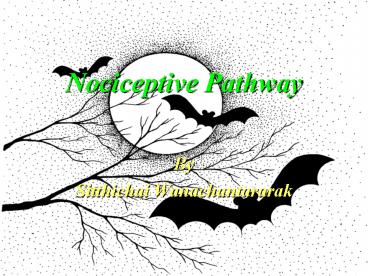Nociceptive Pathway PowerPoint PPT Presentation
1 / 36
Title: Nociceptive Pathway
1
Nociceptive Pathway
- By
- Sitthichai Wanachantararak
2
Pain
- There are several aspects associated with pain
- Sensory-discriminative aspects location,
intensity, duration of the pain - Motivational-affective dimension unpleasant
feeling associated with pain. - Pain has an urgency.
- Pain can be modulated by behavioral experiences.
- There are neural mechanisms that can modulate
pain transmission and the emotional reaction to
pain.
3
Pain
The subjects conscious perception of modulated
nociceptive impulses that generate an unpleasant
sensory and emotional experience associated with
actual or potential tissue damage, or described
in terms of such damage (IASP definition, 1994)
- The subjects conscious perception of modulated
nociceptive impulses that generate an unpleasant
sensory and emotional experience associated with
actual or potential tissue damage, or described
in terms of such damage - (IASP definition, 1994)
The subjects conscious perception of modulated
nociceptive impulses that generate an unpleasant
sensory and emotional experience associated with
actual or potential tissue damage, or described
in terms of such damage (IASP definition, 1994)
The subjects conscious perception of modulated
nociceptive impulses that generate an unpleasant
sensory and emotional experience associated with
actual or potential tissue damage, or described
in terms of such damage (IASP definition, 1994)
4
4 processes of pain sensation
- Transduction receptors
- Transmission
- Primary afferent neuron (first order)
- Secondary order neuron
- Interaction of neuron netween the thalamus,
cortex and limbic system - Modulation
- Perception
5
Sensory Receptors
- Exteroceptor surface of skin and mucosa
- Merkels corpuscle, Meissners corpuscle, Kruses
corpuscle or end bulbs, Free nerve ending - Proprioceptors skeletal muscle for control
movement - Muscle spindle, golgi tendon organ, pacinian
corpuscle, periodontal mechanoreceptors, free
nerve ending - Interoceptors viscera
6
(No Transcript)
7
Structure of peripheral nociceptors and primary
afferents
- What is a nociceptor?
- The peripheral sense organs or receptors, that
respond to noxious stimuli are called
nociceptors. - Definition of a noxious stimulus?
- A stimulus (e.g., chemical, thermal, mechanical)
that can potentially produce tissue damage. - What do nociceptors look like?
- Free-nerve endings
- Nociceptors are widely distributed.
8
Pain vs Nociception
- Pain is the perception of the aversive or
unpleasant sensation that is thought to arise in
a specific region of the body. - Nociception refers to the reception of action
potentials in the CNS evoked by the activation of
specialized sensory receptors (called
nociceptors) that provide information about
tissue damage.
9
Pain vs Nociception
- Not all noxious stimuli that activate these
nociceptors and produce action potentials that
travel towards the CNS, necessarily produce the
experience of pain. - The nociceptive impulses can be gated out and
prevented from accessing higher centers of the
brain.
10
Functions of nociceptors
- Provide information about the location, intensity
and duration of a noxious stimulus to the body - Nociceptors are connected to primary afferent
nerve fibers. - Nociceptors fire action potentials because they
are responding to changes in their chemical
environment.
11
First Order Neuron
- Attached to receptor
- diameter of axon conduction velocity
- A fiber
- alpha (a) 13-20 mm, 70-120 m/s
- beta (ß) 6-13 mm, 40-70 m/s
- gamma (?) 3-8 mm, 15-40 m/s
- delta(?) 1-5 mm, 5-15 m/s
- C fiber 0.5-1 mm, 0.5-2 m/s
12
Generation ofactionpotential
13
Impulse Propagation
14
The Erlanger/Gasser classification of peripheral
nerve fibres (1939)
15
Characteristics of pulpal sensory fibres
(Trowbridge and Kim, 1991)
16
Pain
- Superficial Pain
- Sharp, pricking sensation,
- brief duration(ltmin.)
- 1st pain or initial pain
- Deep pain
- Dull, aching, burning, diffuse,
- long duration (min., hrs., days)
- second pain
17
Nociceptive first order neuron
- Mechanothermal afferents
- A delta fibers c.v. 12-18 m/s response to heat
and mechanical stimuli - Polymodal afferents
- C fiber c.v. 0.5 m/s response to mechanical, heat
and chemical stimuli - High-threshold mechanoreceptive afferents
- mostly A delta response to mechanical, noxious
thermal and chemical stimuli
18
Synapse
19
Synapses at Cell Body
20
Second Order Neuron
- Low threshold mechanoreceptive neuron (LTM)
- tactile, pressure and proprioception
- Nociceptive specific neuron (NS)
- Pain and noxious stimuli
- Wide dynamic range neuron (WDR)
- non noxious to noxious stimuli
21
(No Transcript)
22
Substantia gelatinosa
23
(No Transcript)
24
Brain Stem and Brain
- Brain stem medulla oblongata, pons,
mesencephalon (midbrain) diencephalon - reticular formation of medulla oblongata can
modulate sensory impulses - Thalamus relay station for almost all signal
- hypothalamus --gt produce hormone and interact
with sympathetic --gt nociceptive impulse
25
(No Transcript)
26
Cerebrum
- Cerebral cortex
- thinking process, memory, skill
- area 3, 1, 2
- Basal ganglion
- caudate nu, putamen, globus pellidus
- control gross movement of skeletal
- Limbic system
- emotion and behavior
27
(No Transcript)
28
Trigeminal Sensory Pathway
Primary Neurons
- Nociceptor
- Trigeminal nu.
- Tactile
- Motor nu. of V
- Proprioceptive
- Mesencephalic nu.
29
Second Order Neuron of V
- Low threshold mechanoreceptive neuron (LTM)
- tactile, pressure and proprioception
- Nociceptive specific neuron (NS)
- Pain and noxious stimuli
- Wide dynamic range neuron (WDR)
- non noxious to noxious stimuli
30
TMJ Sensory Pathway
- Proprioceptive
- Golgi tendon organ Muscle spidle
- Proprioceptive receptor in periodontium
- Mesencephalic nucleus of V
- Pain Trigeminal ganglion
31
(No Transcript)
32
(No Transcript)
33
(No Transcript)
34
(No Transcript)
35
References
- Textbook of Physiology
- Textbook of Pain by Wall, P and Melzack, R 4th
edition Churchill and Livingstone 1999. - Disorders and Orofacial Pain. by Klineberg, I
Craniomandibular Wright, Oxford. 1991. - Basic Neuroscience for Health Professions. by
Littell, EH SLACK corporation, New Jersey. 1990.
36
Thank You

